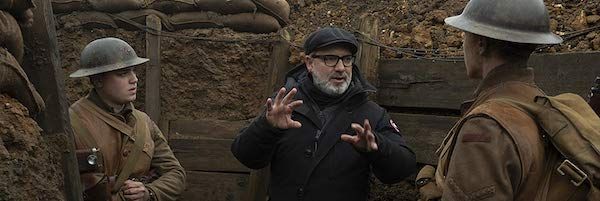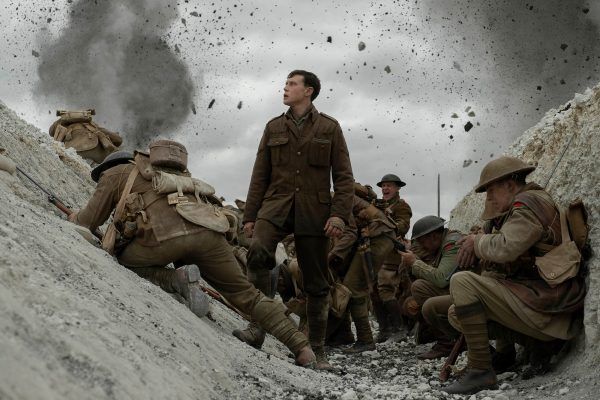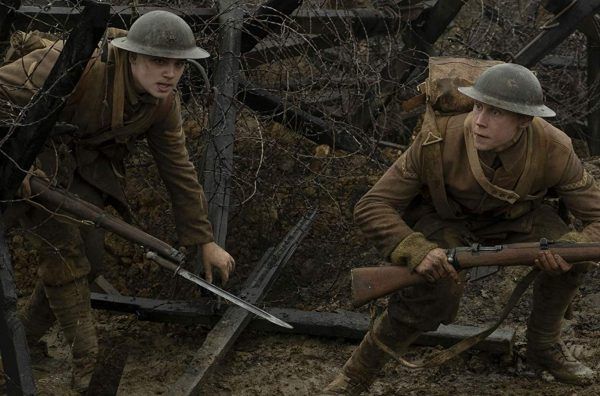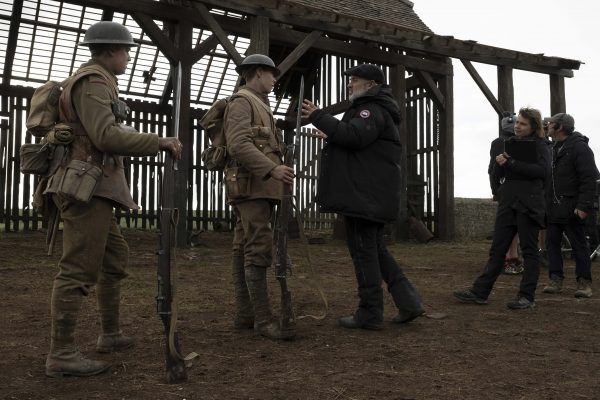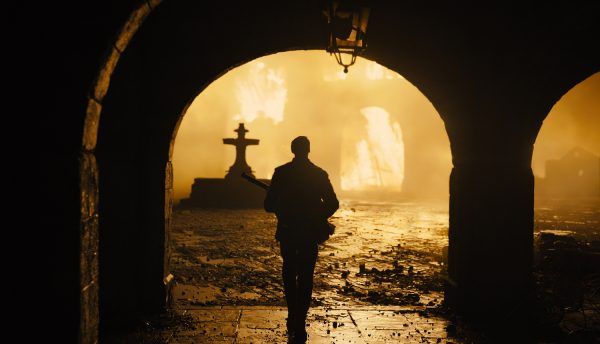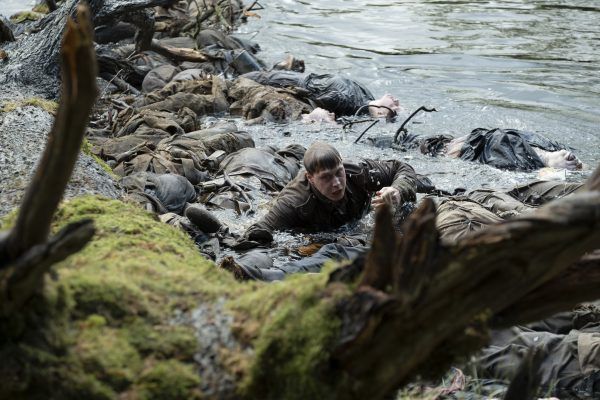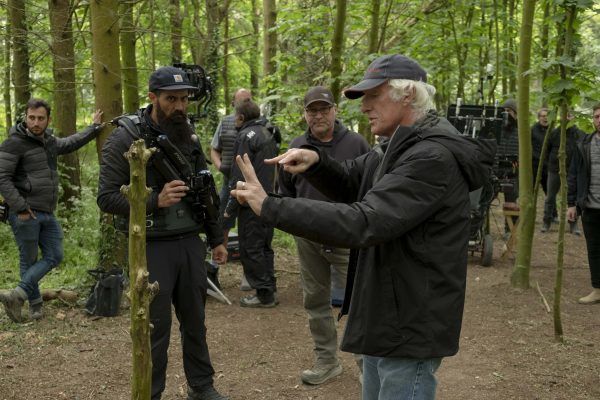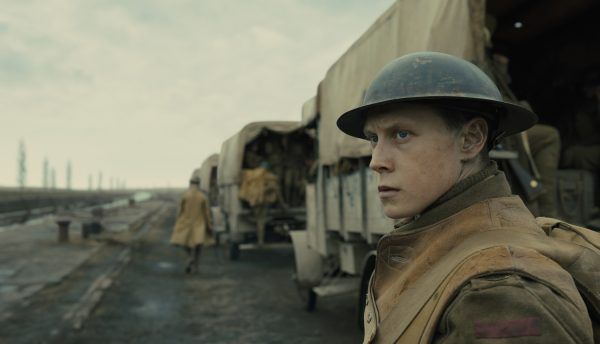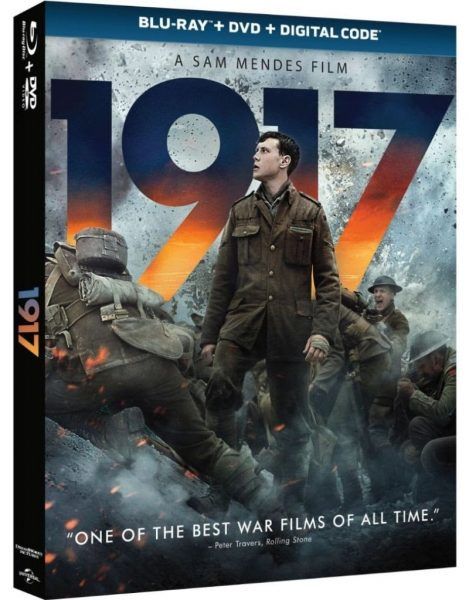Oscar-winning film editor Lee Smith likes puzzles. And it shows. The guy responsible for piecing together timeline-shifting head-scratchers like Inception, Dunkirk, and Interstellar has a knack for crafting complex narratives in ways that make sense, and while it may come as an initial surprise that he’s who director Sam Mendes called to edit his one-shot movie 1917—which is out on Digital HD starting today—once you hear what went into actually putting 1917 together editorially, you’ll understand why he was the perfect man for the job.
1917 presents a World War I-set tale that plays out in one long, interrupted take. Well, two long interrupted takes to be technical about it, and in truth far more takes than that—all of which you can’t see. In an interview with Collider timed to the film’s home video release, Smith recalled that when he and Mendes starting working on 1917, he told the director he would be “The Invisible Man” as far as the public is concerned. If the movie looks like it’s all one take, then he’s done his job well.
But in actuality, filming stretched out over the course of three months and was comprised of multiple setups, takes, and even reshoots. Piecing all of these individual takes together with invisible stitching was Smith’s task, but the nature of the film meant that Lee and Mendes had to decide immediately which take was going to go into the movie, because the next day’s shooting had to match up with the end of that shot perfectly for it all to work. That meant that Smith was actually editing 1917 in real-time throughout production, as opposed to putting the majority of the film together after production had wrapped.
Smith’s work was in such lock-step with production that he was able to screen a cut of half of the film midway through production, with temp music and everything. During our conversation he peeled back the curtain on the invisible challenges that putting together a “one-shot” movie brought, what his work consisted of during post-production, how there are “way more” cuts in the movie than anyone has guessed, and why he’ll never tell exactly how many cuts there are. I also noted how, frankly, it was a little ridiculous that he wasn’t Oscar-nominated for his work on the film, and Smith was unsurprisingly humble in his response. Just what you’d expect from a guy who genuinely loves puzzles.
Check out the full interview below. 1917 is on Digital HD today and will be released on 4K Ultra HD, Blu-ray, and DVD on March 24th.
What’s your reaction when Sam calls you and asks you to edit a one shot movie?
LEE SMITH: Well, my first reaction was I did laugh because he said "You'll laugh when you get the script." He hadn't told me it was a one shot movie. And then on the covering page, it says, ‘the film is to be perceived as it's been shot in one shot.’ And he was correct. I laughed, thinking, "Why are you talking to me?" The script was fantastic and emotional and I read a very early draft and it was so close to being bang on, which is unusual. I was just very excited and when he spoke to me about it I said, "Count me in."
Then we discussed the complexities, obviously, of editing a film that can't look like it's been edited, which all makes sense to me and I've got a lot of experience in my own version of hidden edits, not to mention working with visual effects and figuring out how to disguise things.
So we talked a lot about that, and the transitions, but mainly we just talked about the story. The one thing that we did discuss extensively was that myself as the editor would have to have a very proactive stance as the film was being shot because if there were any pacing or rhythm issues, the ability to edit the film to pace and rhythm in post-production is mainly negated through this shooting style. So, on a daily basis we'd be always talking about whether the particular take that we were trying to find had the correct rhythm, pacing, performance. They all had issues that had to be surmounted, but it was a matter of really making a film as it was being shot, which again is slightly unusual.
I mean, the job of an editor is certainly to quality check and make sure that the coverage is all editable and that can be an ongoing process. It doesn't have to happen on the next day. You normally are in a location for two or three days before the crew move on. There's times where you can catch up or you can hedge your bets and ask for another insert shot or whatever, this was all not really possible on this film. When I did ask Sam if it was possible to reshoot some stuff, which he graciously did, it was a very big ask and we had to be very sure of the reasons and rationales as to what was wrong enough with the shot that required rethinking. And Sam, being a very organic filmmaker also, we'd shoot for the day, maybe get two set ups in the can, and then review them and decide that he wanted to do the whole thing again the next day. Because even with an enormous amount of rehearsal and whatever, you'd never really know what you get until you get into the real location and shoot it, and didn't happen often. But I think we were all extremely diligent and harsh critics of our own work and we managed to get to the other end, and you've seen the results.
It’s insane. I walked out of this movie saying I need to watch a four hour documentary to see how this was made. I’ve been obsessed with films and filmmaking for as long as I can remember, and I cannot for the life of me figure out exactly how this was done. Which I think is a testament to your guys’ work.
SMITH: Yeah, it's not for the faint hearted. We had a few hiccups and roadblocks along the way that all have to be very quickly analyzed and quite often it was down to me to make the call that I thought that it was possible, and then we would continue, because you're kind of painting yourself into a corner every day and if you're wrong, it could be kind of catastrophic. If you can imagine on any one day there were up to like 39 takes and that take had to be selected by both myself and Sam by the time the camera rolled the next day for the take that would join onto it, because each take ended slightly differently. The film wasn't computer controlled, it wasn't shot with motion capture. It wasn't shot in any of the ways that you would have assumed something where you had to get ultimate lineups to make transitions would be shot. It was just shot in the old-fashioned way.
We still had to figure out—even though we thought that everything would work, and more often than not it did work—there was some surprising things that threw themselves up that just had to be resolved extremely quickly. And I was very fortunate that I had four very seasoned compositors plus my assistants who were also very, very good with blending and using very tricky wipes to just test and prove that we could be confident to say we could get these shots to seamlessly come together. And some of them, on a daily basis, Sam was always was delighted when we'd send him back that night the shots joined together and he'd go, "I have no idea how you do that." It was a good learning curve and a huge team effort from all departments.
I was going to ask, so would it be fair to say that you essentially edited this film in real time? If you were having to select the shot the night before that would match up to the shot the next day, was it all kind of flowing together that way?
SMITH: Yeah, absolutely. And I was updating Sam with the cut every night, so the film built itself on the duration of the shoot. And I'm adding music and effects, because I'm checking pace and rhythm, we couldn't wait for post-production because you're getting to post on a regular film and you can adjust pace and rhythm till the cows come home. You can change your music style and slow the imagery down. You can change the music style and speed it up. You can do all sorts of things that were going to be very, very limited on this film. So, I was selecting temp music the whole time, putting in, I had a sound crew working with me because what I was basically saying is we have to make this look like it's a finished film every single day.
And then we would join it together, send it back to Sam, he could watch it because everything informs the next shot. And if you felt, say, you did a longer dialogue scene, you suddenly felt like, oh, okay, what's coming down the pipe now is going to be too long winded. You could address that in how you shoot the next day, realizing that the pace of rhythm is everything. A film like this could fall over very quickly if that wasn't being continuously tweaked as you were shooting. So, that was a fascinating process. And halfway through the shoot, Sam was so pleased with half the film that he said can you come up and screen it in the middle of England somewhere. We hired a high quality theater room, went in there with all the department heads, and we ran the movie. And I'd already put opening credits on the film, it had music, it had sound effects. It looked like you were watching a completed movie up until halfway, which was the exact day that they shot the day before they showed the last shot pegged on.
That's crazy.
SMITH: They all said afterwards, “That was the most surreal experience I've ever had shooting a movie.” (laughs)
If I'm not mistaken, I think they were still shooting last fall. So, the day the film finished shooting, like the day after, was the editing basically done?
SMITH: Well, I mean it was certainly a completed film the day after they finished shooting. But having said that, there was still a massive amount of work that we were doing to visual effects and speed ramming and we were doing all manner of things. I also had the ability to then put in anything that I could find that was better from any other take. If I could get it into the film, I would. And there was some fun secret squirrel editing that went on amongst takes that were never designed to have an edit point put in them. So, I got to put various other takes into the select takes when you were still striving for perfection. Just trying to get that little nuance that you could see and if I could figure out a cunning way of getting it in, I would. So, we were busy the whole time. It was a fascinating process. It was amusing to me because a few people who don't really understand the process were saying oh, you must have had a cushy ride on that one. I said, "Yeah, no." (laughs) It was very, very busy. And it's a fairly short duration for a feature film of that scale. So, it wasn't like we weren't super busy the whole time.
How many total cuts are there in the film?
SMITH: Now, Sam and I made an agreement that we would never say.
Oh, really. Interesting.
SMITH: Because it's fun, and I know they’ve run competitions and things. And you said it's kind of fun for people that are that interested, they can try and work it out themselves. But I can tell you now, everyone that has guessed has been so far out, it's almost comical.
Would you say it's more than people would imagine or fewer than people would imagine?
SMITH: Oh, way more. Way more. I actually had an interviewer saying to me that they had it on very good opinion, and I'm thinking, "that's funny, they're talking to the editor," that there were six edits. And I laughed and I said, "Well, think about it, the film's shot over four months." So, if you can imagine that the camera never stopped rolling, why would we have been there for that long? None of that makes any sense. So, I think you can do some rough mathematics and work it out, but that doesn't come close. I mean, there was some very long takes and there were some extremely short takes. So, the fun of it is over the years people can frame over on their DVD players or whatever they want. I'm sure there'll be the old film school that’s loaded it into an avid and see if they can discover where they are. And some of them you will discover, but some of them, I seriously doubt.
When I sat down to watch the movie, I was kind of mentally saying, "Oh, I'll try and track if I can see where the hidden cuts are." But by five minutes into the movie, I was so drawn into the story and the characters, I just completely forgot to keep track.
SMITH: That was the important part we agreed with, is nothing to be flashy about the way this was done. This is just trying to make an exquisitely well-made film. But really, nobody at first look should ever be interested in the editing and if we've done our jobs right, and you've said exactly what industry professionals have said. We had one of the guys who was mastering the audio at the end of the job, who I've known for many years and he said he was laughing to himself the whole way through because he sat down and he said I'm going to count the edits and then I'm going to be clever and turn around and tell me how many there are. And he said exactly what you said about five minutes into the film. He completely forgot. I said, "Well that's because it's an engaging film."
You're basically watching a really beautifully made film so, technically, you shouldn't be thinking about it if the film is doing its job. And sure, it's fun to analyze it later. But I remember watching Birdman and I mean Birdman has quite a few actual edits, but there was quite a few times where I completely forgot I was watching a film that was made to look like it was one shot. After I figured out what they were doing, I could pick those quite easily. But it was a different kind of a movie. So yeah, it was just interesting.
It's a fascinating process and a challenge to all departments, costume, makeup, everything has to be so, I mean, more than perfect because you don't have the joy of being able to cut away from someone and when you come back to them their hair looks different. I mean, there are things in regular films, I had a guy get in a lift wearing one tie and get out wearing a different tie. That's editing, it was a combination of two scenes that had to get folded into one. Back in the day, didn't have visual effects to help us, but no one ever spotted it. It wasn't about the tie. So, there are things like that, but I'm sure there'll be a website shortly that'll analyze the film upwards and downwards and forwards and backwards and they'll undoubtedly see things that we didn't see. Like I said, we were pretty particular.
You’re such a well renowned editor, you're kind of a legend in the industry for putting together these really complex films like Interstellar and Dunkirk. And here, you have 1917, which is at the complete opposite end of the spectrum on paper in that it's all real time and it's all linear. Did you find it more challenging working on this kind of film? Did you initially think it'd be kind of refreshing to not have to layer in so many different timelines and stuff?
SMITH: I think it's just anything that challenges me professionally, I find very, very exciting. And each of the films that you've mentioned are extremely complicated, but for different reasons. And I think this film just exercised a completely different... It kind of redirected my entire thought process from conventional editing. So, it was kind of exhilarating in that respect. And I think a few people have said it wasn't as complex as Dunkirk. It was, but for an entirely different reason. But yeah, they're both extraordinarily, complicated films. But I guess I just love puzzles and solving strange things and I think that's what attracts me to those kinds of projects.
I still think it's insane that you didn't get not only an Oscar nomination, but an Oscar for this movie. I just think people are taking for granted the editing that they don't see.
SMITH: Yeah, it's fine. And Sam, we talked about that jokingly quite early in the process and I said I'm going to be The Invisible Man on this one, but that's okay. It's just, unless you actually work on one of these films, they're actually extremely difficult to notice. And even as an editor, I would've had to have sat down with someone who cut something like this and probably talk to them for a couple of hours to have any true, deep understanding of what you're in for because I really felt that it was kind of reinventing the wheel a little bit as we were going, because we wanted to find our own path through this film. We also wanted to never shy away from the seemingly impossible, which was also exciting. So yeah, in that respect, it was incredibly rewarding. I've got no regrets, but I mean, awards are awards, but they generally follow the—and I've worked on plenty of them—the flashier, easy to see, highly edited films. That's the way it goes.
Well I still think it’s a fantastic feat of filmmaking.
SMITH: It's funny, I keep winning, I won a lot of critics' awards, so I don't know what that means. (laughs)

